Like almost any small commercial marina, the one in Kitamat in British Columbia, Canada, offers a vista of bobbing prawn boats, orphaned trailers and jumbles of rusting mystery equipment. Sprawled on the opposite shore is a multinational-owned aluminum smelting plant. As my conveyance and home for the next week, the touring tug Swell, chugs away from the dock under a chilly rain, I assume more such sights lie ahead.
But when the smokestacks dwindle in our wake, a gaze off the bow reveals miles of deep, choppy channel flanked by steep forests and exposed peaks blanketed in melting snow that produces waterfalls gushing through the evergreens down to the craggy shoreline. From high perches, eagles pause their hunting to sternly eye our progress.
This swift, full dose of coastal British Columbia will define a journey intended to transport us via increasingly remote waterways north of Vancouver through the Great Bear Rainforest on the way to isolated Kitlope Lake, if weather and water levels cooperate. There will be shore-tromping excursions, and we’ve all but been promised up-close sightings of a variety of local wildlife.
Some of my fellow passengers are card-carrying, telephoto-toting birders, but frankly, unless a feathered creature is the size of a pterodactyl, I can’t be bothered. I’m intent on an encounter of the megafauna kind, as this region boasts more brown and black bears than you can shake a stick at—not that I hope to find myself shaking a stick at either.
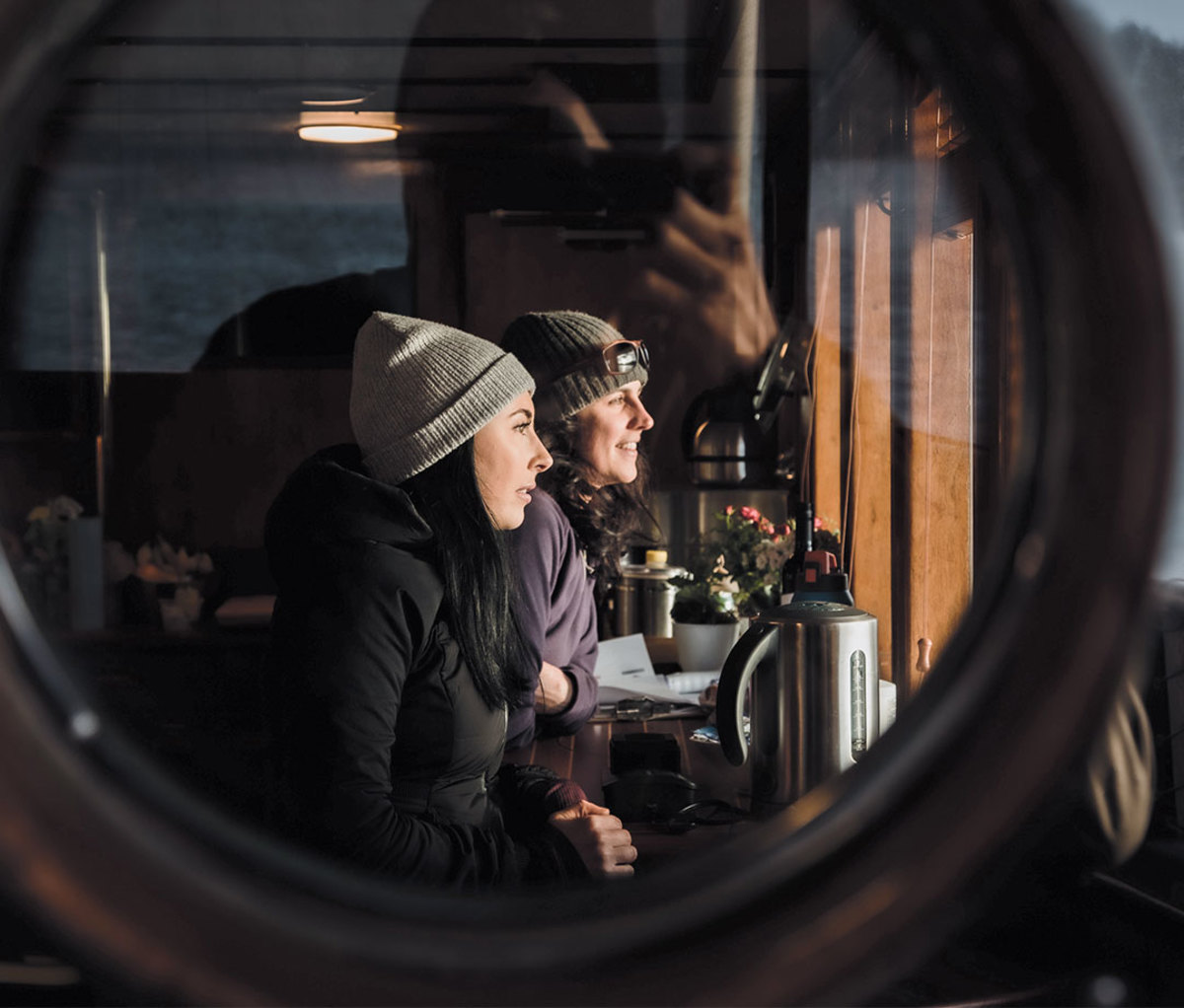
Technically a cruise, this already doesn’t feel anything like the stereotype of floating cities with lido decks and day spas. The 88-foot Swell has only six guest cabins, and even the communal dining and lounge spaces are decidedly cozy. An aft stairwell and fore ladder connect lower and upper decks, and while treading the narrow, sloped port and starboard walkways it’s best to keep your wits to avoid klutzing over rope cleats or the heavy-duty winch that cranks a 600-pound anchor.
My cabin is handsomely unfussy, accented with pinewood and portholes. The head offers precious little knee room between toilet and sink, but I’ve seen worse in Manhattan studio apartments. Thoughtfully, the walls are studded with plenty of hooks, the better to air out damp adventure clothes.
After hastily squaring away my gear, I’m back on deck, drizzle be damned, not yet willing to miss much of the unfolding waterscape. As we didn’t get underway until late afternoon, not many more nautical miles are clocked before finding a calm anchorage in Eagle Bay, where captain Rob Taylor descends from the bridge to further the obligatory safety briefing. Sporting a messy topknot and a nautical-themed, full-sleeve tattoo depicting a pirate, Taylor is also somewhat of a Swell newcomer, having recently relocated across the breadth of Canada from Newfoundland and a marine career that includes towing massive oil rigs. Distracted by unfamiliar surroundings and shipmates, and the smell of roasted salmon wafting from the galley, I perhaps don’t absorb the briefing’s finer points—is six bells the signal to abandon ship, or seven? And is it bells or horn blasts? Wait, why would we need to abandon ship? Oh well, dinner and a nice pinot grigio are being served. I’m sure that if we capsize in the middle of the night, someone will mention it to me.
Brewing the first pot of predawn coffee is probably not among a captain’s duties, but thank the gods Taylor does so, as I’m running on an internal clock still set several time zones ahead. “Everyone drinks a lot of coffee on this trip,” he says. He’s right; whether owing to brisk mornings or the robustness of the locally roasted joe, my consumption at least doubles. Harbor seals splash noisily nearby, and as the tug motors into Devastation Channel (not as ominous as it sounds), I spot a trio of porpoise glide through our wake. On the lookout for additional wildlife, crew naturalist Ethan Browne folds his tall frame into a patient squat directly beneath the bridge, high-powered binoculars deployed. Overcast skies still threaten, so the plan is to use today to push the diesel engine near the top cruising speed of 10 knots and cover 65 nautical miles to Kitlope by evening.
Being aboard Swell is also a trip into the past. She’s a working girl, built in 1912 to haul loads of lumber, coal and steel to booming coastal communities from Seattle to Alaska. Her tug duties spanned 92 years until a sport-fishing service performed a $3.5 million refit, leading to her acquisition in 2014 by boutique cruise operator Maple Leaf Adventures. If you like traveling by water, she’ll get you where you’re going. But if you have an affinity for old boats, in particular tugboats, then you love Swell, her fat aft low in the water and curved gunwales rising to a proud, high bow.
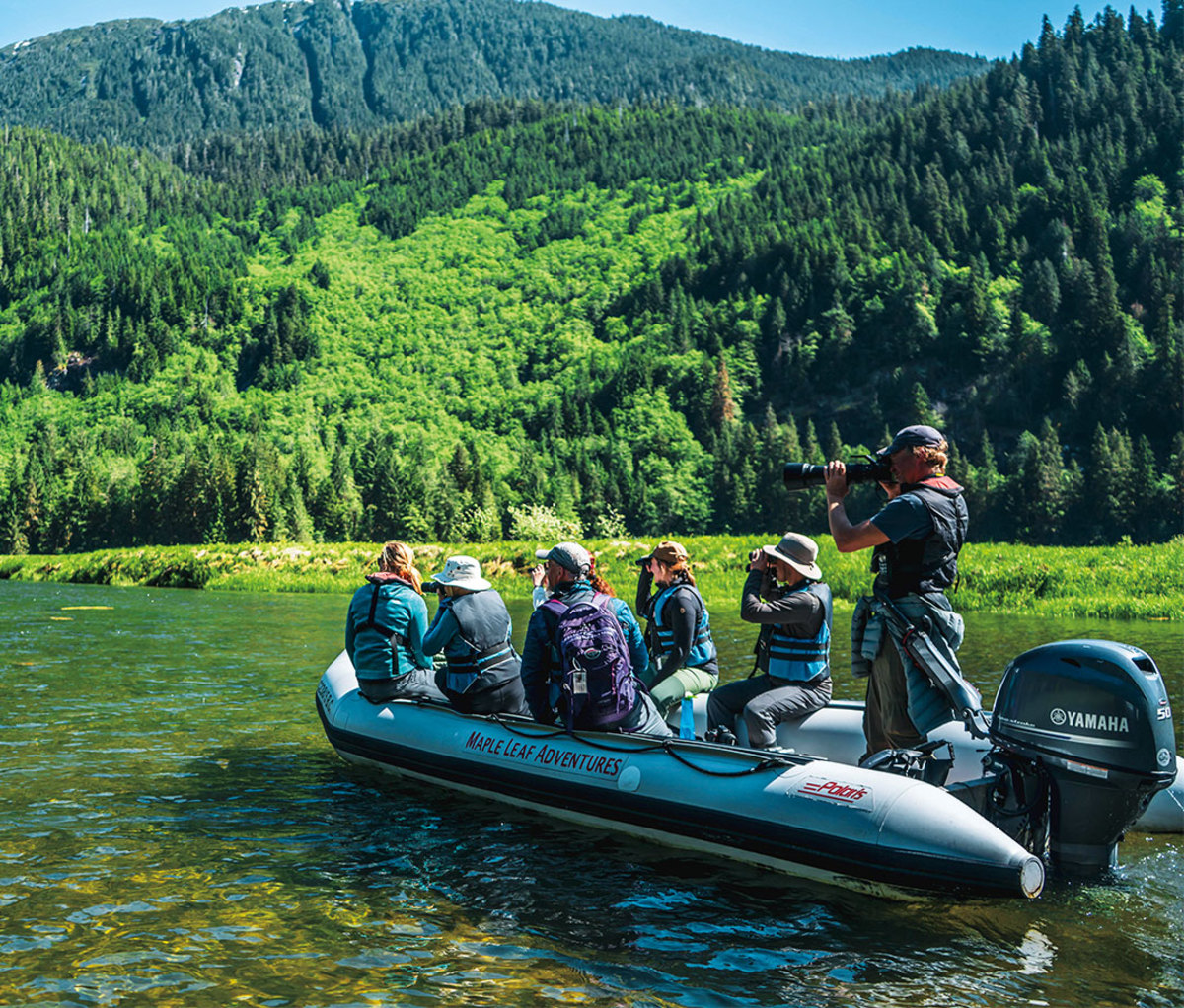
When she reaches a wide fork to Gardner Canal, British Columbia coast’s longest fjord, guests and crew assemble afore. This is the traditional boundary between the indigenous Haisla and Henaaksiala peoples, and we mark the crossing as they did, maneuvering Swell in a circle while dropping pinches of tobacco (in our case, loose tea) into the water. I admit that such re-created rituals don’t really reach me; I’m more struck that there’s not another boat in sight. Indeed, we won’t share our passage with more vessels than I can count on my fingers for the remainder of the trip.
Dramatic views grow more so, the shorelines tighter and snowier peaks climbing into cloud cover. Apparently, we make excellent time, as an afternoon announcement instructs us to load into the two inflatable “tender” boats. We pull them up to a natural hot spring consisting of a wooden changing platform that shelters a pair of hot tub–size pools. The captain himself goads us to alternate between the 104-degree spring and cold plunges into the glacial channel waters.
The next morning, bright and clear, again finds us in the tenders, attempting a long sortie up a brackish stream too narrow and see-the-bottom shallow for Swell. A group the previous week foundered before reaching the goal of Kitlope Lake, but we’re counting on fresh snow melt to boost our odds. Frequent storms rage here; every bend reveals goalpost-tall tangles of downed, scoured tree trunks—fir, cedar, spruce—jammed against the edges like a giant’s Jenga game.
Our guides, Carmen Pendleton and Carrie Poborsa-Cox, deftly steer us through swift tidal currents until the stream finally opens up to a wide, long lake framed by postcard mountains and waterfalls. Its forested shores were once home to several Henaaksiala villages, with a population in the thousands. Now it’s completely depopulated, a process that began centuries ago with the arrival of white men’s diseases down through the government’s forced relocation of indigenous children to infamous “residential schools” until the 1950s. Though thoroughly wild, this place emanates the composed aesthetic of a cathedral, and whether it’s that ambience or a reflection on broken history, whatever stirring I didn’t feel from the boat-circling ceremony, I certainly feel here.
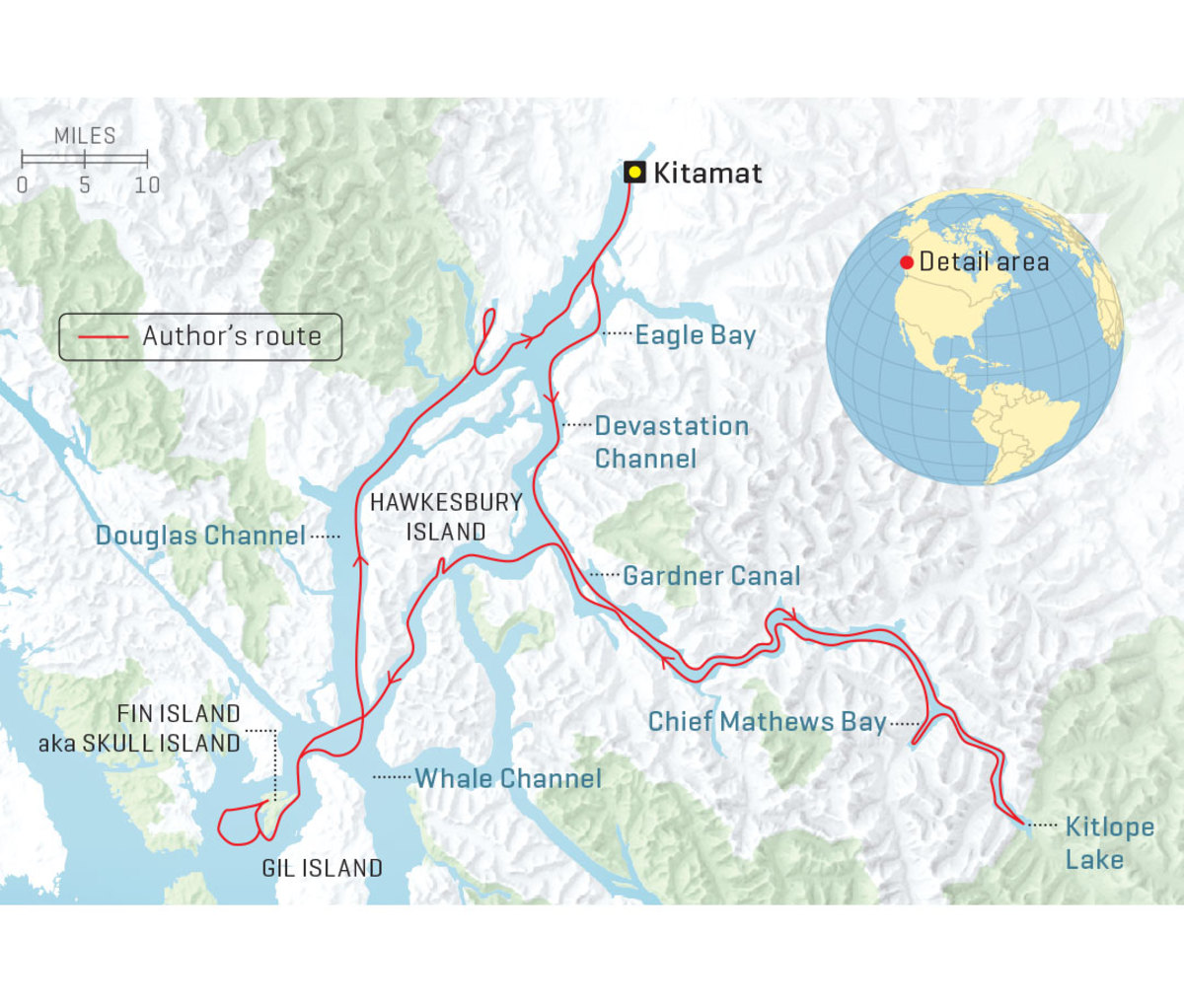
On the way back downstream, Browne pulls us over to get a closer look at bear tracks he spotted earlier in a strip of sand, but the rising tide has washed them away. We drift maybe 30 seconds more before chatter in the lead tender goes silent, replaced by a charge in the air. Then we’re face-to-face with the stoutest grizzly I’ve ever seen—until an even stouter grizzly rises from behind. Mama and her nearly grown cub are grazing on sedge grass at water’s edge maybe 25 yards away from our tenders, which suddenly feel dinky and vulnerable. Mama, more wary, shuffles into partial tree cover, while the cub keeps munching—and takes a sizable dump while staring straight at us. Energized and back aboard Swell, we uncap a bottle of good single malt. Browne terms the cub’s reaction to our presence a “stress poop,” but I object—more likely he was just demonstrating that he didn’t give a literal shit.
It rains 300 days a year here, so another sunny dawn seems like we’re cheating somehow, even if it makes for excellent sightseeing. The slopes along the first legs of the trip had been thick with trees, but it wasn’t until we reached the Kitlope area of British Columbia that I walked into true old growth forest. The understory, carpeted with ferns or impenetrable with brush, smells loamy. Sunlight ebbs beneath a variety of centuries- old trees—I’m drawn to a Sitka spruce with limbs cocooned in moss and a trunk so prodigious that three of us can’t link arms around it. Only recently did a conservation campaign formally protect the surrounding 320,000 hectares, establishing the largest unlogged temperate rain forest in the world.
IF YOU HAVE AN AFFINITY FOR OLD TUGBOATS, THEN YOU’ll LOVE SWELL.
Traveling back down Gardner Canal, my newly trained eyes can better spot expansive swaths of former clear-cut. Logging companies, a major economic force in British Columbia, are now required to reforest, but they mostly plant commercially advantageous Douglas fir, fostering the uniform green of a near-monoculture. I’m told that beyond the ridges lie clearcuts that stretch for miles.
Anchorage in Chief Matthews Bay brings the chance to use Swell’s kayaks. I paddle near a waterfall so pounding it generates its own buffeting breeze that nearly flips me, then cross the wide bay to a mini-glacier until shrieking gulls chase me away from a hidden nest.
The next couple of days pass not so much in a blur as in a state of boat travel-induced zen. I sleep soundly, rise early and eat heartily on can’t-believe-this-is-tug-fare meals whipped up by always-busy, always-smiling galley chef Lila Ruzicka. (Special shout-out to the lamb chops.) I haven’t looked at a screen or talked on a phone for nearly a week—there is no connectivity for such modernities out here.
Cruising in the tenders, we witness a big black bear being totally and hilariously horny for a plank of driftwood lumber. (Canadian bears are freaks!) On another shore excursion, we stride across tide-exposed rocks smothered in rockweed, a seaweed with plump, greenish tips. Told they’re edible, I pop a few in my mouth. Not repulsed by the briny if slightly slimy taste, I dub them “gherkin of the sea.” Farther up the tidal zone, even odder finds include a barnacle the size of a volleyball and a mussel the length of a man’s forearm. By the time we notice that the wet sand is embedded with hundreds of pulsing, multicolored sea anemones, I wonder if rockweed might be a hallucinogen, until a non-partaker blurts out, “Where have we landed, fucking Skull Island?” Detox-at-sea avoided.
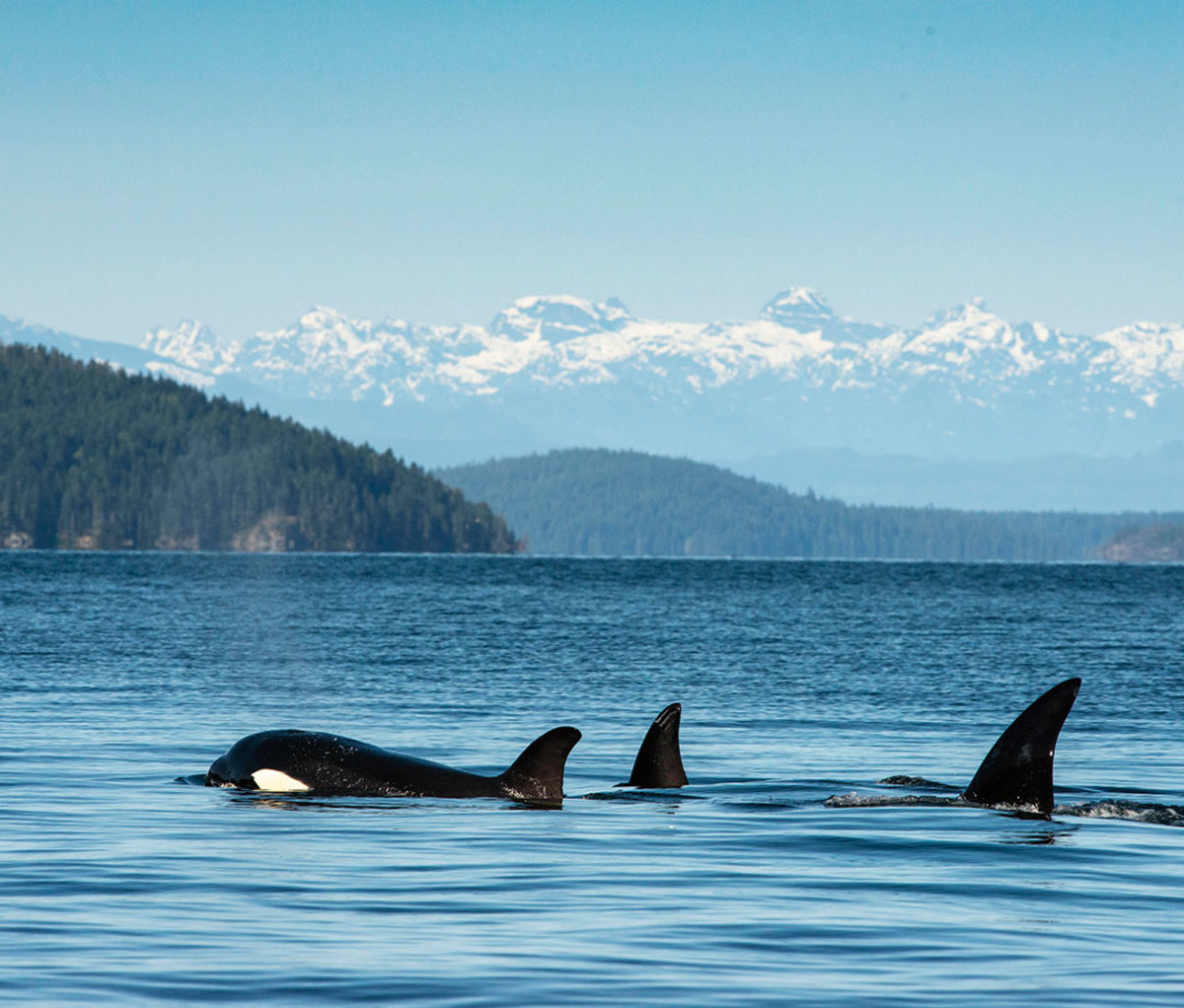
As the final hours of our British Columbia journey flow into Swell’s wake, nautical reverie is surpassed by a desire to check another of God’s creatures off the must-see wildlife list. We’ve become a boat of harpoonless Ahabs, obsessing over whales. Passing through promisingly named Whale Channel, someone spots a humpback’s telltale spout in the distance, but my binoculars can’t find it. Soon after, an irregular motion breaks the chop to starboard. A black fin slides into view, then several, then we’re upon a pod of seven sleek orcas, including a big male with a dorsal fin the height of a surfboard. (OK, orcas are technically members of the dolphin family, but we’re not splitting cetacean hairs.) The pod swims fast and in unison, neatly slicing the waves like the beautiful marine serial killers that they are.
A few hours later, a voyage totaling 235 nautical miles ends back where it started. The modest Kitamat marina, still bordered by beached hulls and rusting debris, now appears beautiful. Not because it’s the most civilization I’ve seen in a week, but because this is where I first beheld Swell. Too bad there are no postcards for sale.
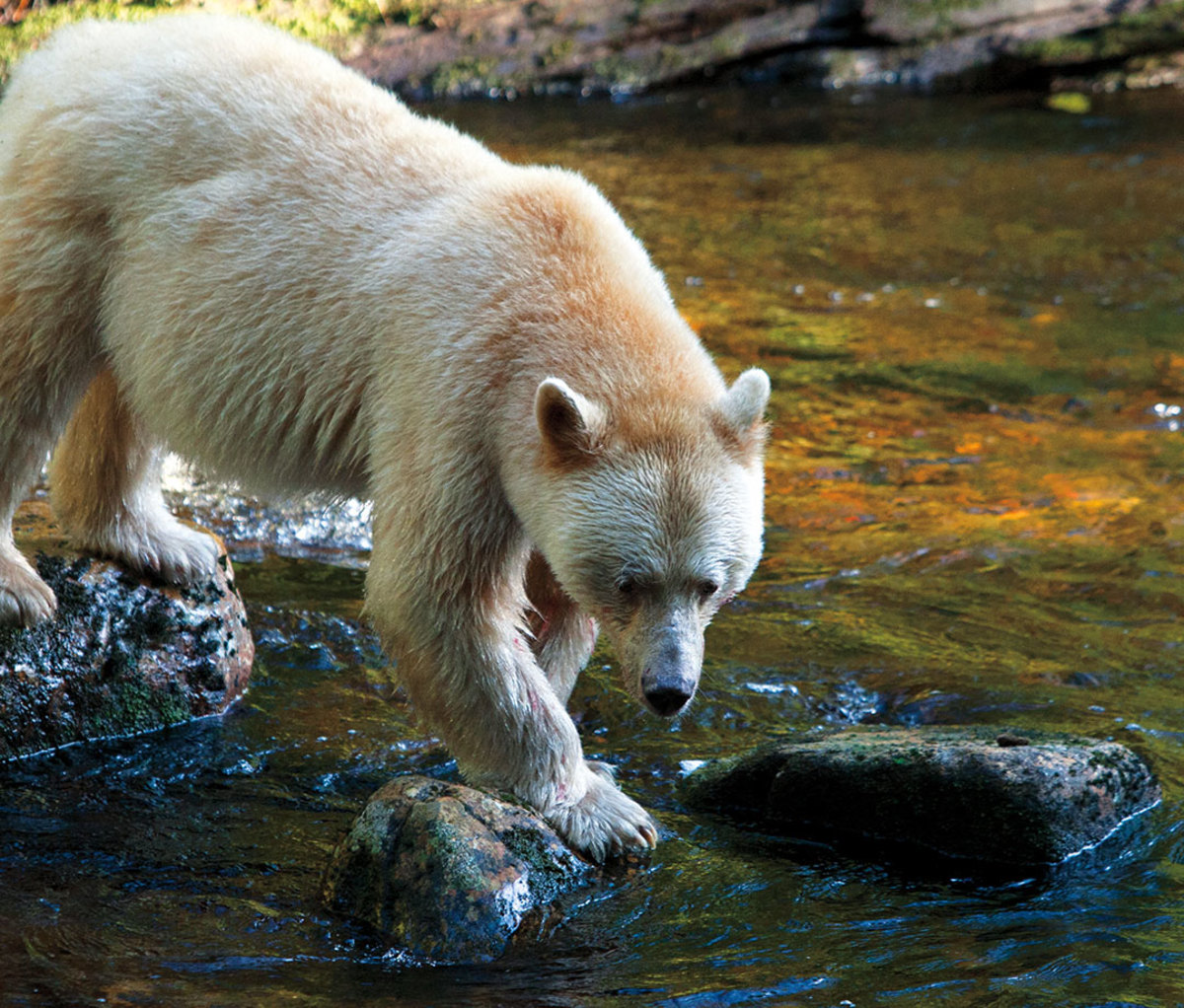
A Rare Bear in British Columbia
IF YOU’RE TOURING coastal British Columbia and spot the beast in the above photo, you might think a polar bear wandered too far south. Don’t be silly—it’s a black bear. OK, more specifically, it’s a subspecies of black bear known as a spirit bear. And no, it’s not an albino, as the nose and eyes are of normal color. Instead, it’s the result of a double recessive gene that can produce white-furred offspring in a select population of black bears. Spirit bears exist only along BC’s north coast, especially on islands within the Great Bear Rainforest, and with a population less than 500, are one of the world’s rarest bears.
A legend of the indigenous Tsimshian people holds that the white bear was created to remind us of the Ice Age. A recent university study suggests that evolution played a part—white-furred bears have an advantage when hunting salmon over black-furred bears that stand out more starkly against the light sky. Spirit bears aren’t especially secretive, but giving their rarity, spotting one isn’t a sure thing. To boost your odds, visit the region after autumn rains, when bears gather at upland streams to feast on running salmon. And yes, they’re adorable, but no petting.
from Men's Journal https://ift.tt/d4wNhKm






No comments:
Post a Comment